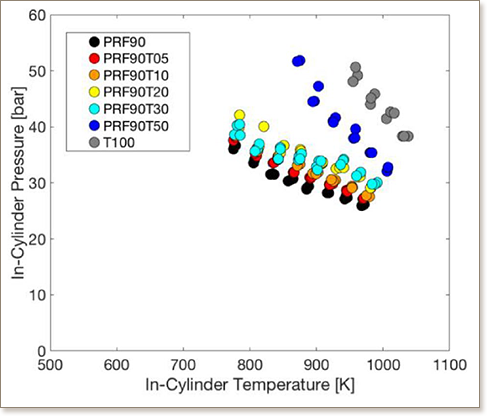
Homogeneous charge compression ignition (HCCI) experiments were run with the aid of a Cooperative fuel research (CFR) engine, operating at 600 rpm and under very lean conditions (ϕ = 0.3). This study seeks to examine the combustion behavior of different fuels by finding the pressure-temperature (p-t) conditions that instigate the start of combustion, and the transition from low temperature combustion to principal combustion. The pressure-temperature diagram emphasizes p-t conditions according to their traces through the compression stroke. In each fuel tested, p-t traces were examined by a sweep of the intake temperature; and for each experimental point, combustion phasing was maintained at top dead center by adjusting the compression ratio of the engine. In addition to the p-t diagram, results were analyzed using a compression ratio-intake temperature diagram, which showed the compression ratio required with respect to intake temperature.
Pure n-heptane, isooctane and toluene were investigated first. The results showed that these three fuels ignited in accordance with their octane number. The compression ratio-intake temperature diagram shows that the compression ratio decreased linearly with increased intake temperature. The p-t diagram reveals that the combustion of n-heptane always reacted with low temperature heat release, while toluene always reacted with one main combustion. However, isooctane behavior is subject to change. Isooctane combustion displayed two stages of combustion with low intake temperature, but when intake temperature increased, the low temperature heat release disappeared and only the main combustion remained. Finally, ignition delays computed from a constant volume model were compared to experimental ignitions; the results suggested that another model was required.
Second, an octane number 90 primary reference fuel (PRF90) with different volume fractions of toluene was investigated. Results in the compression ratio-intake temperature showed that the compression ratio decreased linearly, while the intake temperature increased for PRF90 without toluene. When low fractions of toluene were added to PRF90 (from 5% to 30%), higher compression ratios were required and the trend became non-linear. A slight change in the compression ratio at low intake temperature was observed; while a greater change in the compression ratio at high intake temperature was required due to the presence of low temperature combustion. Finally, high fractions of toluene (higher than 40%) quenched the low temperature combustion and linear behavior was again achieved. The pressure temperature diagram also shows similar trends, with a transition of the low temperature combustion which moved in accordance with the fraction of toluene in PRF90.
